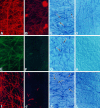Actin plays a role in both changes in cell shape and gene-expression associated with Schwann cell myelination
- PMID: 8987752
- PMCID: PMC6793673
- DOI: 10.1523/JNEUROSCI.17-01-00241.1997
Actin plays a role in both changes in cell shape and gene-expression associated with Schwann cell myelination
Abstract
Schwann cell (SC) differentiation into a myelinating cell requires concurrent interactions with basal lamina and an axon destined for myelination. As SCs differentiate, they undergo progressive morphological changes and initiate myelin-specific gene expression. We find that disrupting actin polymerization with cytochalasin D (CD) inhibits myelination of SC/neuron co-cultures. Basal lamina is present, neurons are healthy, and the inhibition is reversible. Electron microscopic analysis reveals that actin plays a role at two stages of SC differentiation. At 0.75-1.0 microg/ml CD, SCs do not differentiate and appear as "rounded" cells in contact with axons. This morphology is consistent with disruption of actin filaments and cell shape changes. However, at 0.25 microg/ml CD, SCs partially differentiate; they elongate and segregate axons but generally fail to form one-to-one relationships and spiral around the axon. In situ hybridizations reveal that SCs in CD-treated cultures do not express mRNAs encoding the myelin-specific proteins 2',3'-cyclic nucleotide phosphodiesterase (CNP), myelin-associated glycoprotein (MAG), and P0. Our results suggest that at the lower CD dose, SCs commence differentiation as evidenced by changes in cell shape but are unable to elaborate myelin lamellae because of a lack of myelin-specific mRNAs. We propose that F-actin influences myelin-specific gene expression in SCs.
Figures







Similar articles
-
Expression of the protein zero myelin gene in axon-related Schwann cells is linked to basal lamina formation.Development. 1993 Nov;119(3):867-80. doi: 10.1242/dev.119.3.867. Development. 1993. PMID: 7514526
-
Anti-beta 1 integrin antibody inhibits Schwann cell myelination.J Neurobiol. 1994 Oct;25(10):1207-26. doi: 10.1002/neu.480251004. J Neurobiol. 1994. PMID: 7529296
-
Transforming growth factor-beta blocks myelination but not ensheathment of axons by Schwann cells in vitro.J Neurosci. 1995 Jan;15(1 Pt 1):419-28. doi: 10.1523/JNEUROSCI.15-01-00419.1995. J Neurosci. 1995. PMID: 7823146 Free PMC article.
-
Studies of the initiation of myelination by Schwann cells.Ann N Y Acad Sci. 1990;605:1-14. doi: 10.1111/j.1749-6632.1990.tb42376.x. Ann N Y Acad Sci. 1990. PMID: 2268113 Review.
-
Regulation of myelin-specific gene expression. Relevance to CMT1.Ann N Y Acad Sci. 1999 Sep 14;883:91-108. Ann N Y Acad Sci. 1999. PMID: 10586235 Review.
Cited by
-
Cell elongation induces laminin alpha2 chain expression in mouse embryonic mesenchymal cells: role in visceral myogenesis.J Cell Biol. 1999 Dec 13;147(6):1341-50. doi: 10.1083/jcb.147.6.1341. J Cell Biol. 1999. PMID: 10601345 Free PMC article.
-
Identification of genes that are downregulated in the absence of the POU domain transcription factor pou3f1 (Oct-6, Tst-1, SCIP) in sciatic nerve.J Neurosci. 2002 Dec 1;22(23):10217-31. doi: 10.1523/JNEUROSCI.22-23-10217.2002. J Neurosci. 2002. PMID: 12451123 Free PMC article.
-
N-cadherin mediates axon-aligned process growth and cell-cell interaction in rat Schwann cells.J Neurosci. 2002 May 15;22(10):4066-79. doi: 10.1523/JNEUROSCI.22-10-04066.2002. J Neurosci. 2002. PMID: 12019326 Free PMC article.
-
MAL overexpression leads to disturbed expression of genes that influence cytoskeletal organization and differentiation of Schwann cells.ASN Neuro. 2014 Sep 10;6(5):1759091414548916. doi: 10.1177/1759091414548916. Print 2014. ASN Neuro. 2014. PMID: 25290060 Free PMC article.
-
GABA-B receptors in the PNS have a role in Schwann cells differentiation?Front Cell Neurosci. 2013 Jan 10;6:68. doi: 10.3389/fncel.2012.00068. eCollection 2012. Front Cell Neurosci. 2013. PMID: 23335881 Free PMC article.
References
-
- Aguayo AJ, Charron L, Bray GM. Potential of Schwann cells from unmyelinated nerves to produce myelin: a quantitative ultrastructural and radiographic study. J Neurocytol. 1976a;5:565–573. - PubMed
-
- Aguayo AJ, Epps J, Charron L, Bray GM. Multipotentiality of Schwann cells in cross-anastomosed and grafted myelinated and unmyelinated nerves: quantitative microscopy and radioautography. Brain Res. 1976b;104:1–20. - PubMed
-
- Barth J, Ivarie R. Polyvinyl alcohol enhances detection of low abundance transcripts in early stage quail embryos in a nonradioactive whole mount in situ hybridization technique. Biotechniques. 1994;17:324–326. - PubMed
-
- Bermingham JR, Scherer SS, O’Connell S, Arroyo E, Kalla KA, Powell FL, Rosenfeld MG. Tst-1/Oct-6/SCIP regulates a unique step in peripheral myelination and is required for normal respiration. Genes Dev. 1996;10:1751–1762. - PubMed
Publication types
MeSH terms
Substances
Grants and funding
LinkOut - more resources
Full Text Sources
Other Literature Sources
Research Materials
